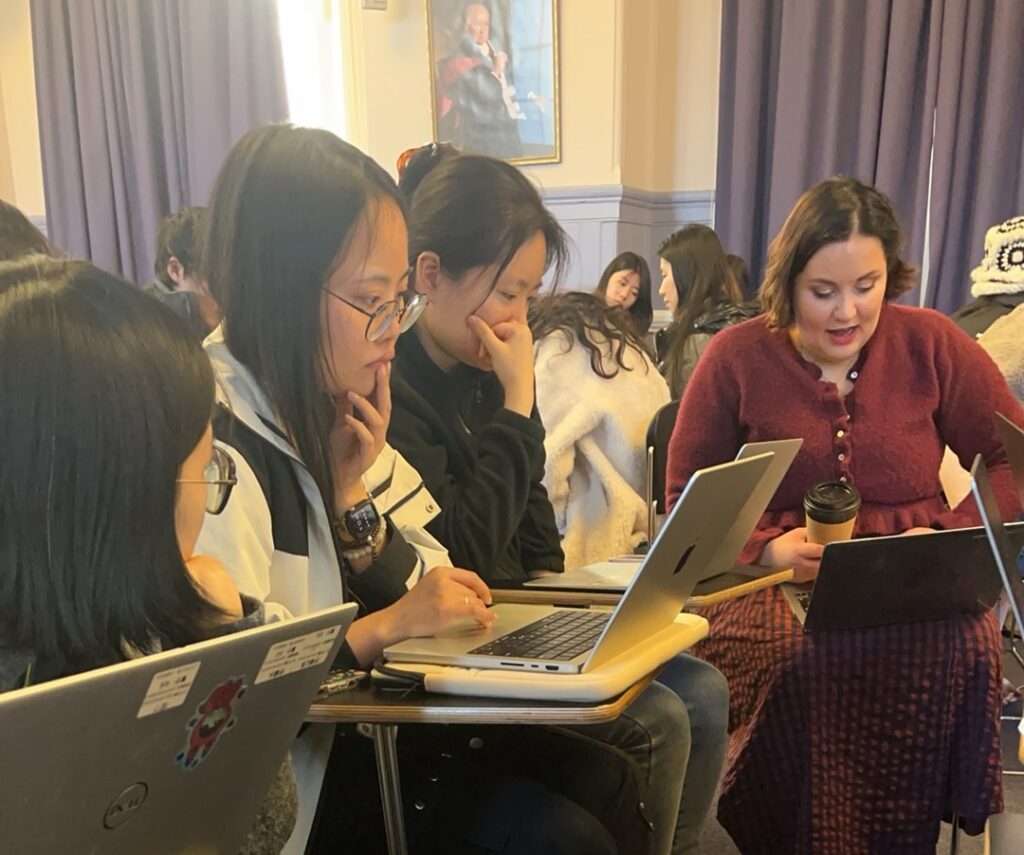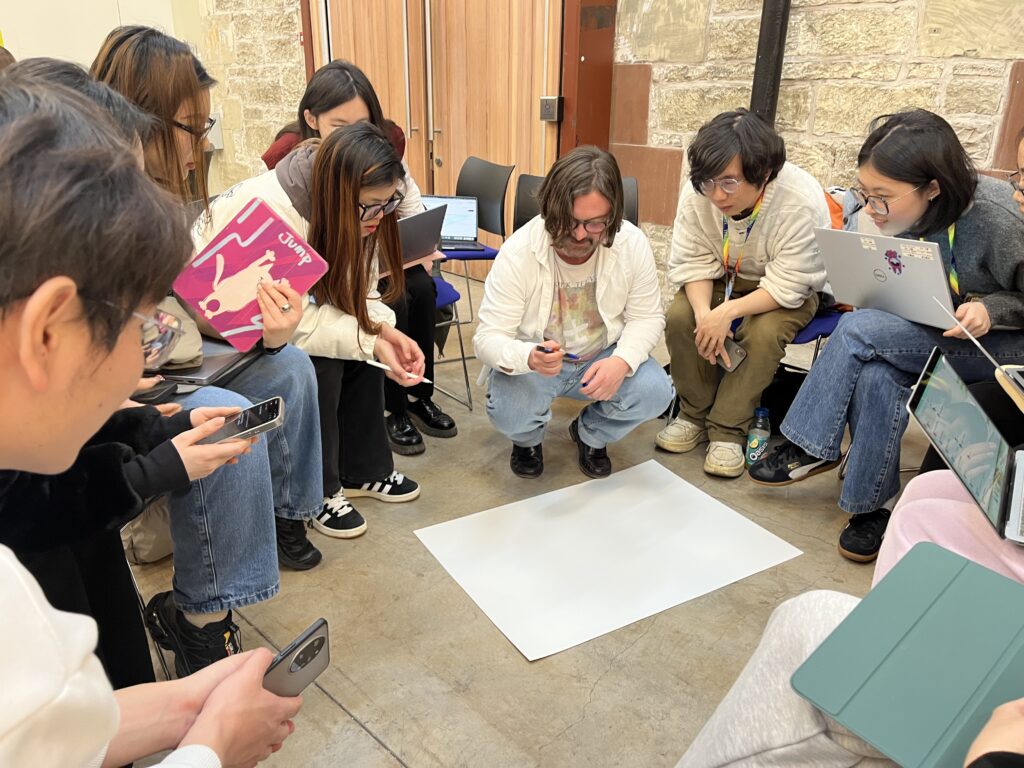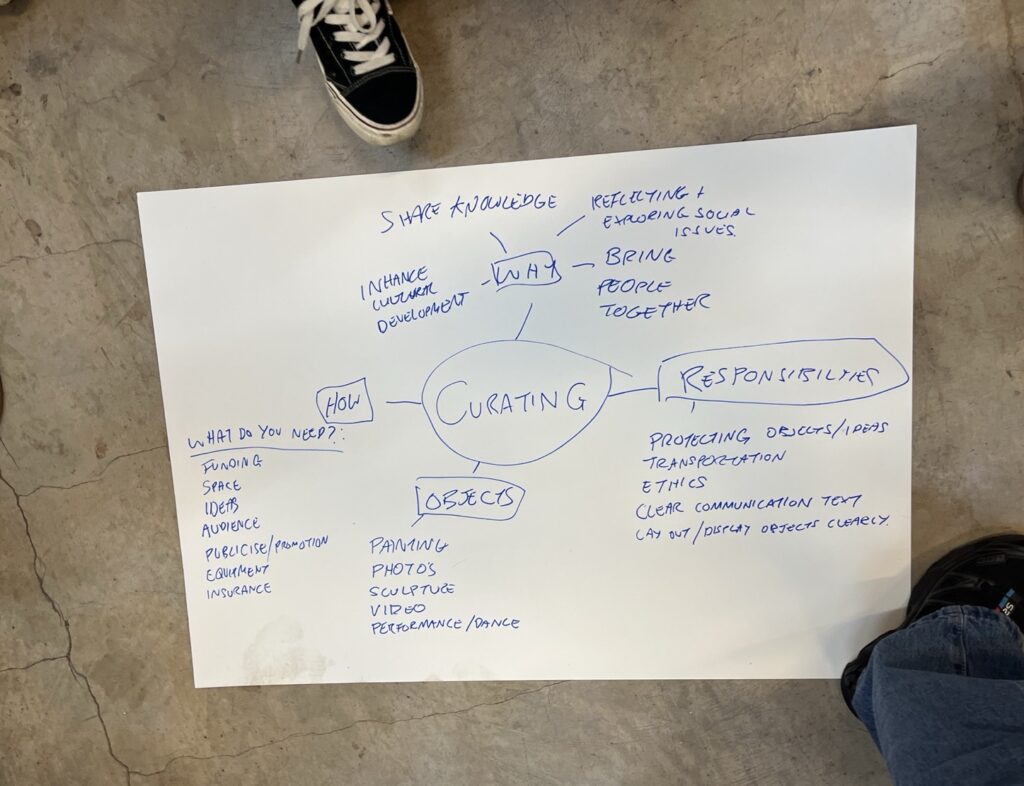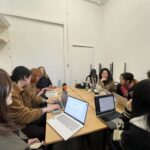Introducation:
- Julie Louise Bacon’s lecture, “Curating in a Time of Broken Globalisation”, examined the impact of globalization’s instability on curatorial practices and discussed how curators navigate this uncertainty.
This week’s course provided us with an initial understanding of contemporary curatorial practices while emphasizing the core values of criticality, creativity, and care. Julie Louise Bacon’s lecture, Additionally, this week marked the formation of our curatorial collective, an essential step toward collaboration in the course.

Curating in a Time of Broken Globalisation
- Curators function more as translators or creators whose medium is the work of others” (Thea, 2010)
As globalization faces increasing instability, curatorial practices must continuously adapt. The lecture explored how contemporary curating repositions itself amid economic, political, and cultural uncertainties and how curators serve as mediators of knowledge production. As Carolee Thea notes in On Curating: Interviews with Ten International Curators, “Curators function more as translators or creators whose medium is the work of others”(Thea, 2010). This highlights that curators are not just organizers of exhibitions but key facilitators of connections between art, society, and audiences.
- This made me reflect on whether we could consider decentralized curatorial approaches, such as temporary exhibitions, digital curating, or community art projects.
The reading materials further developed this discussion. Ronald Kolb et al., in Centres / Peripheries – Complex Constellations, examined the centre-periphery dynamic in curatorial practices, emphasizing how major urban art institutions dominate discourse while peripheral regions and non-mainstream practices remain underrepresented (Kolb et al., 2019).
- Small Visual Arts Organisations (SVAOs) play a crucial but often overlooked role in exhibition-making. Unlike large-scale institutions, SVAOs focus on micro-curating, emphasizing local, community-driven initiatives (Bilbao, 2018)
This perspective encouraged me to think about how curatorial projects can integrate with local culture and social issues rather than solely focusing on large-scale, mainstream exhibitions.
Understanding the Curatorial Collective Model and Key Curatorial Concepts
During this week’s planning meeting, we officially formed our curatorial collective and discussed curatorial models and key concepts. Curatorial collectives emphasize collaboration rather than individual curatorial authority, aligning with Carolee Thea’s idea that “Curating is an evolving, interdisciplinary field.”

We began by introducing ourselves and sharing our sources of interest in curating. This process helped us better understand each other and our varying perspectives on curatorial practices. We then discussed past curatorial experiences and curatorial directions we find compelling, allowing us to develop a deeper sense of exploration and envision our future work in curating.
To better understand the core elements of curating, our group created a mind map during our discussion, summarizing key curatorial concepts, including the purpose of curating (Why), curated objects (Objects), curatorial responsibilities (Responsibilities), and the resources needed for the curatorial process (What do you need?).

-
The Purpose of Curating (Why)
Curating is not just a process of showcasing artworks; it is also a crucial means of sharing knowledge, enhancing cultural development, reflecting on and exploring social issues, and bringing people together. This demonstrates that curating is not merely about the display of art but serves as a key platform for fostering dialogue, stimulating critical thinking, and promoting social engagement.
-
Resources Needed for Curating (What do you need?)
Curating requires a wide range of resources, including funding, exhibition space, curatorial concepts (ideas), audiences, publicity and promotion, equipment, and insurance. This reflects that curating is not only an artistic practice but also a process that involves planning, management, and execution, ensuring that exhibitions run smoothly and maximize their impact.
-
Curatorial Responsibilities (Responsibilities)
Curators are not only responsible for planning exhibitions but also for protecting objects and ideas, managing transportation, considering ethical implications, ensuring clear communication through exhibition texts, and organizing a well-structured layout and display of objects. This highlights that, beyond artistic and creative aspects, curators must also focus on the practical feasibility and ethical considerations of the exhibition.
-
Curated Objects (Objects)
We discussed the various media involved in curating, including painting, photography, sculpture, video, and performance/dance. This demonstrates that curatorial formats can be diverse and should not be limited to traditional exhibition spaces. Instead, curating should explore more experimental presentation methods, such as immersive exhibitions and cross-media curation.
Summary:
This week’s discussions reinforced that curating is more than exhibition-making—it is a practice that can engage with social issues and foster cultural dialogue. Through lectures and readings, I gained insight into how curators adapt to global instability and use decentralized curatorial approaches to reach diverse audiences. Additionally, through our curatorial collective discussions, we established a foundation for collaboration and refined our understanding of key curatorial elements.
In future blog posts, I will explore real-world examples of decentralized curating and consider how these concepts can be applied to my individual curatorial project (SICP).
References:
- Bacon, J.L. (2025) Curating in a Time of Broken Globalisation. [Lecture] Edinburgh College of Art, University of Edinburgh.
- Bilbao Yarto, A.E. (2018) Micro-Curating: The Role of SVAOs (Small Visual Arts Organisations) in the History of Exhibition-Making. Notebook for Art, Theory and Related Zones.
- Kolb, R., Regli, C. and Richter, D. (2019) Centres / Peripheries – Complex Constellations. Notes on Curating, Issue 41, June.
- Thea, C. (2010) On Curating: Interviews with Ten International Curators. ARTBOOK | DIGITAL.







